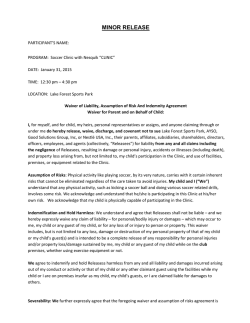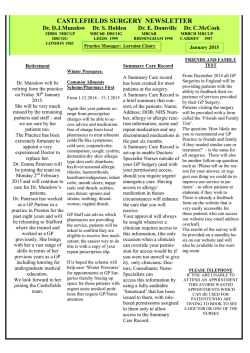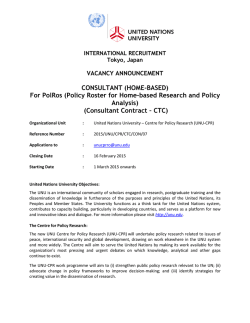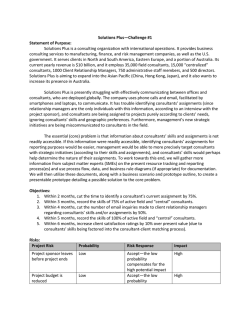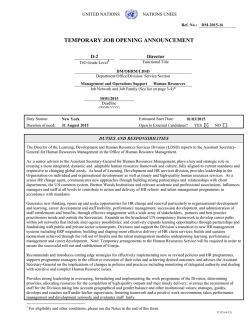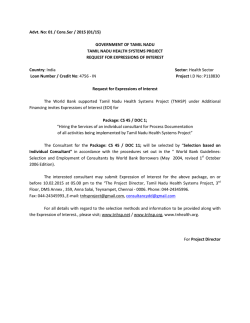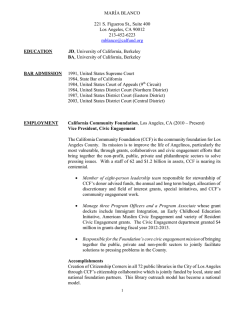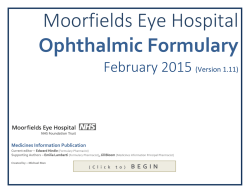
Mobile clinics for chronic stable glaucoma management
Quality and Productivity: Proposed Case Study Mobile clinics for chronic stable glaucoma management: improving access and alleviating hospital demand Provided by: Ipswich and East Suffolk Clinical Commissioning Group and Ipswich Hospital NHS Trust Publication type: Proposed quality and productivity example Sharing good practice: What are ‘Proposed Quality and Productivity’ case studies? The NICE Quality and Productivity collection provides users with practical case studies that address the quality and productivity challenge in health and social care. All examples submitted are evaluated by NICE. This evaluation is based on the degree to which the initiative meets the criteria of savings, quality, evidence and implementability. Proposed quality and productivity examples are predominantly local case studies that meet most of the criteria but are yet to be fully implemented. This may be because they are at an early stage of implementation and further evidence is forthcoming. These proposed examples may still be of interest. Additional information will be requested within a year from the date of publication. A summary of findings is provided below along with comments and recommendations about how this case study may be developed. Overview This initiative provides local care to people with stable or low-risk glaucoma using a mobile clinic. The clinic is based in a community setting and regularly visits 4 locations throughout rural Suffolk. All necessary tests are performed in 1 appointment, which lasts about 1 hour. All results are recorded electronically and reviewed by consultant ophthalmologists using a web-based system, to ensure the quality of decision-making. This initiative aims to improve productivity by reducing demand for appointments from low risk patients in hospital eye clinics, allowing the hospital to see more complex cases. The patient experience should improve because the number of appointments required for testing is reduced and the clinic is brought to locations nearer patients’ homes. NICE comment It is predicted that the annual saving will be around £96,000 per 100,000 population based on a reduction in the number of appointments needed to complete the required tests, and a reduced follow-up outpatient tariff. Because this is a new initiative no outcomes data are available and savings have not been demonstrated in the long term; however, this information should be available for future updates to this case study. Page 1 of 7 This document can be found online at: http://www.evidence.nhs.uk/qualityandproductivity Proposed Quality and Productivity topics Details of initiative Purpose To improve the quality, convenience and cost effectiveness of chronic stable glaucoma management using a mobile clinic. Description (including scope) The initiative provides local care to an older population in a rural area. The main drivers for the scheme were long waits for tests using the existing service, and national policy requiring improved local access to services. A mobile clinic, which has been named the ‘i-van’, contains all the equipment needed to review glaucoma patients. Patients are initially referred to the hospital for their first appointment by their GP or optician, as in the standard process. The hospital consultants then decide which patients can have follow-up appointments (usually every 6 or 12 months) using the mobile clinic. The van’s team includes an optometrist, 2 clinical assistants and 1 administrator. The entire appointment takes about 1 hour, and patients are able to undertake all necessary tests in 1 appointment. In the previous system, patients were seen on average 2.75 times to undertake the same tests. The mobile service moves to 4 different locations and no patient should now have to travel for more than a 20–30 mile return journey. The service can see up to 20 patients a day. All results are recorded electronically and are reviewed by consultant ophthalmologists using a web-based system. This is a significant quality difference between this community glaucoma service and others that use optometrists working alone. Furthermore the consultant is able to provide a more detailed and accurate review using the software, since it is easy to look back at data and retinal images for accurate comparison. About 12% of patients have revised management plans after the consultant has reviewed the case. It is more economical for consultant ophthalmologists to review the optometrists’ test results and decisions than for them to perform the tests in the first place. Topic Long-term conditions, primary care commissioning and contracting, productive care, right care, safer care. Other information Glaucoma affects 1–2% of people aged over 40 and 10% of people aged over 70. Glaucoma is a treatable condition, but it is the reason for more than 10% of all blind registrations and so has a significant impact on whether people are able to live independently. Because glaucoma is so common, it places a large burden on all hospital eye departments. Up to 80% of glaucoma patients have stable disease, but they still need regular monitoring, which involves systematic screening checks at each visit. Since visual field testing alone takes half an Page 2 of 7 This document can be found online at: http://www.evidence.nhs.uk/qualityandproductivity Proposed Quality and Productivity topics hour, often it cannot be undertaken at the appointment and so older and visually impaired patients may have to return for multiple appointments. Since different staff, from consultants to nurses, see these patients, it is difficult to ensure consistent management, especially when full assessments cannot be undertaken in a single appointment. Savings anticipated Amount of savings anticipated Total savings in the first year could be around £370,000. This is based on 3500 patients with stable or low risk glaucoma using the service. There is an average reduction of 1.75 appointments per patient creating the potential of a saving of £60 per appointment, depending on local service provision. This is equivalent to an annual saving of about £96,000 per 100,000 population, depending on local service provision. The contract is phased over 3 years. This allows for incremental increase in activity levels, based on demographic growth and patients transferring into the service from acute hospital. For example, increasing from 3500 to 5000 patients over 3 years. Type of saving Potential cash savings from fewer appointments because all tests are completed in a single appointment, if the reduction in appointment numbers results in a reduction in staff and administration, facility costs . There could also be cash savings from paying a reduced outpatient follow-up tariff, if agreed locally. Any costs required to achieve the savings The cost of change is included in the agreed local tariff. No purchase of equipment is required because the equipment is owned by the mobile clinic service provider. Ultimately the cost for the service is paid for through the ongoing service fee, but it does avoid an up-front investment for equipment by the Trust. If purchase of the necessary equipment and recruitment of new staff to perform this work is necessary, the up-front costs would be much higher. Programme budget Problems of vision. Supporting evidence Initial results demonstrate patients are completing their tests in a single appointment, consistent with the anticipated benefits. Quality outcomes anticipated Impact on quality of care or population health There is likely to be an improvement in care quality for patients with stable, low-risk glaucoma who are assessed in the mobile clinic. This is because they can be seen sooner, are less likely to Page 3 of 7 This document can be found online at: http://www.evidence.nhs.uk/qualityandproductivity Proposed Quality and Productivity topics miss appointments and all optometrist decisions are reviewed electronically by consultant ophthalmologists. Patients with unstable, higher risk glaucoma will also benefit because reduced demand means more appointments will be available at the hospital eye clinic. Impact on patients, people who use services and/or population safety Patient safety is likely to be improved. Patients are more likely to have the necessary tests completed to monitor their condition as the total number of appointments is reduced, minimising the chance of missed appointments. In addition the consultant is able to undertake detailed reviews using software that enables rapid access to patient notes, test results and images, helping to ensure any changes are spotted. Impact on patients, people who use services, carers, public and/or population experience The patient or carer experience is improved because patients can attend appointments at a more convenient location and can have all necessary tests in 1 appointment. Previously patients needed to visit the hospital an average of 2.75 times to undergo all tests required. Supporting evidence Outcomes data are not yet available, but service data suggest that there has been a decrease in missed appointments since the initiative began. Evidence of effectiveness Evidence base for case study The initiative is based on other similar schemes within acute trusts, such as a mobile eye clinic in Bristol (British Journal of Ophthalmology 2014). Evidence to date of deliverables from implementation The service is relatively new, so outcomes data are not yet available. Data for patient numbers and waiting times are not yet available, but the number of missed appointments has decreased since the introduction of the scheme. Anecdotally there has been a positive response from patients who have used the service, but this has not been systematically assessed. Supporting evidence No further information provided. Feasibility of implementation Implementation details Discussions took place between Ipswich and East Suffolk Clinical Commissioning Group (CCG) and Ipswich Hospital NHS Trust about the proposed mobile glaucoma clinic. It was agreed that the Page 4 of 7 This document can be found online at: http://www.evidence.nhs.uk/qualityandproductivity Proposed Quality and Productivity topics clinic would provide a service to patients with stable, low-risk glaucoma who would be referred by hospital consultants after their first appointment. Patients would not be referred directly by their GP or optician. It was agreed that patient notes would need to be digitised to allow clinicians to view them and record their findings alongside them. A detailed service specification was established and a bidder review panel was formed to scrutinise any bids. A company was chosen that met the requirements set out in the service specification. The chosen company employs the optometrists and provides all the equipment. The van housing the mobile clinic is owned by the company, but alterations have been made to meet local specifications. The CCG branding and the community glaucoma service livery have been placed on the side of the van. A bank of consultant ophthalmologists was recruited by the service provider to review the optometrists’ work. Consultants are paid per review, which makes it easier to match demand and capacity. This is included in the service cost. Before the scheme began the company archived patient notes onto their computer system through access at the local hospital. Information governance arrangements were agreed and signed; only information in terms of patient demographics and details relevant to care for glaucoma were included. Access to notes for data transfer within the live service is handed over when the patient is discharged into the care of the follow-up mobile clinic service. It was agreed that the mobile clinic could park in the grounds of the hospital initially. Four other areas in rural Suffolk were identified where the mobile clinic could provide care closer to patients’ homes on different days, and this is the model now used. Patients who have been assessed by the hospital eye clinic as having stable or low-risk glaucoma with a 6- or 12-month followup interval and no other eye conditions are considered for the mobile clinic service. All patients are fully briefed on the mobile service by the hospital clinician and by letter. Patient information is also provided by the mobile clinic service. The patient records are then uploaded to the mobile clinic system. All results are recorded electronically and consultant ophthalmologists review the optometrists’ work using a webbased system. About 12% of patients have their management plan amended by the consultants. This may change the follow-up period or the treatment. The changes are summarised in a letter and patients are told to wait for this letter for confirmation of the management plan. Reviews are usually completed within 24 hours of the appointment by the designated consultant. If they are unavailable the review may be referred to the bank of consultants to ensure that it is reviewed within 7 days. Urgent clinical response is available if an urgent review is required, as Page 5 of 7 This document can be found online at: http://www.evidence.nhs.uk/qualityandproductivity Proposed Quality and Productivity topics indicated by the optometrist. If a patient’s condition requires referral into secondary care or an emergency attendance, a referral letter will be generated automatically. A full clinical report for all appointments attended within the community glaucoma service is also produced to support the consultant team at the hospital. This includes the clinical history, examination findings, visual field analysis reports and optic disc images. Patients referred back into the trust who are considered unstable should be seen within 6 weeks; those who are high risk will be referred for same-day treatment. The service was launched on the agreed date and preliminary results and patient feedback have been positive. Time taken to implement Implementation of the initiative can be achieved between 1 and 3 years, including all planning and tendering. Ease of implementation This initiative involves cooperation between a CCG and an acute hospital trust in procuring the services of a mobile clinic provider. Archiving patient data onto the new system was time-consuming for the mobile clinic provider and was done over a series of weekends, requiring additional staff. Once this was done, implementation was relatively easy. Level of support and commitment Some consultants felt that work had been taken away from them, but the lead clinician was supportive of the scheme. The scheme received an early visit from eye clinic nursing staff, who saw the benefits and supported the initiative. Barriers to implementation It is essential to gain agreement from the local trust. This may prove to be a barrier initially because hospital trusts get paid for each appointment and they may see this initiative as losing income. However, if demand outweighs existing capacity, as in this case, then reducing the burden on hospital eye clinics will not reduce overall income. Risks There is a risk that patient care could be compromised if consultants are not available to review the optometrists’ recommendations. This risk is mitigated by having a bank of consultants who are available to review the recommendations. Supporting evidence No extra information provided. Further evidence Dependencies Implementation requires the support of the local trust and senior clinical staff, since they must identify patients with chronic stable Page 6 of 7 This document can be found online at: http://www.evidence.nhs.uk/qualityandproductivity Proposed Quality and Productivity topics glaucoma from their clinic caseload. Notes have to be converted to electronic form, which is part of the initial implementation. There must be an area, or areas, in which the mobile clinic can park and that patients can get to easily. Consultants must be available to review the recommendations of the optometrists, although this is the responsibility of the service provider. Contacts and resources Contacts and resources If you require any further information please email: [email protected] and we will forward your enquiry and contact details to the provider of this case study. Please quote reference 13/0002 in your email. British Journal of Ophthalmology (2014) Service innovation in glaucoma management: using a web-based electronic patient record to facilitate virtual specialist supervision of a shared care glaucoma programme. ID: 13/0002 Published: January 2015 Last updated: January 2015 Page 7 of 7 This document can be found online at: http://www.evidence.nhs.uk/qualityandproductivity
© Copyright 2025

